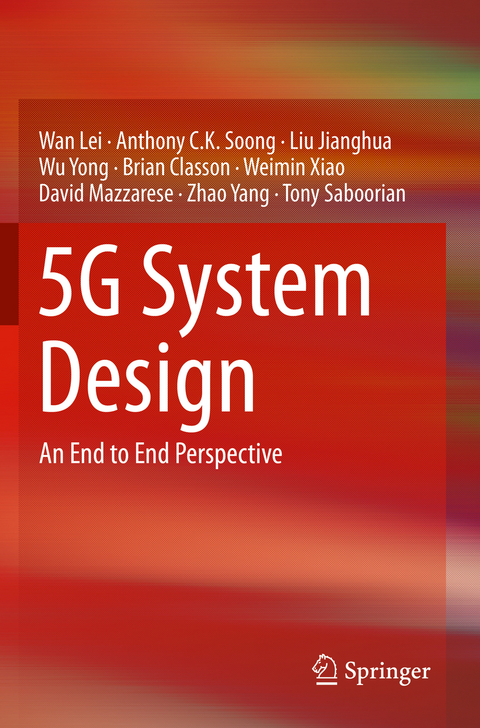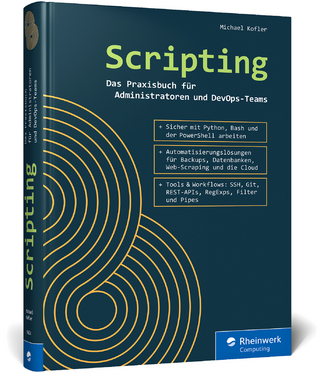
5G System Design
Springer International Publishing (Verlag)
978-3-030-22238-3 (ISBN)
This book is structured into six chapters. The first chapter reviews the use cases, requirements, and standardization organization and activities for 5G. These are 5G requirements and not NR specifically, as technology that meets the requirements, may be submitted to the ITU as 5G technology. This includes a set of Radio Access Technologies (RATs), consisting of NR and LTE; with each RAT meeting different aspects of the requirements. The second chapter describes the air interface of NR and LTE side by side. The basic aspects of LTE that NR builds upon are first described, followed by sections on the NR specific technologies, such as carrier/channel, spectrum/duplexing (including SUL), LTE/NR co-existence and new physical layer technologies (including waveform, Polar/LDPC codes, MIMO, and URLLC/mMTC). In all cases the enhancements made relative to LTE are made apparent.
The third chapter contains descriptions of NR procedures (IAM/Beam Management/Power control/HARQ), protocols (CP/UP/mobility, including grant-free), and RAN architecture. The fourth chapter includes a detailed discussion related to end-to-end system architecture, and the 5G Core (5GC), network slicing, service continuity, relation to EPC, network virtualization, and edge computing. The fifth and major chapter describes the ITU submission and how NR and LTE meet the 5G requirements in significant detail, from the rapporteur responsible for leading the preparation and evaluation, as well as some field trial results.
Engineers, computer scientists and professionals with a passing knowledge of 4G LTE and a comprehensive understanding of the end to end 5G commercial wireless system will find this book to be a valuable asset. Advanced-level students and researchers studying and working in communication engineering, who want to gain an understanding of the 5G system (as well as methodologies to evaluate features and technologies intended to supplement 5G) will also find this book to be a valuable resource.
lt;b>Wan Lei is a Huawei fellow and currently head of Wireless Standard, Huawei Tech. Co. Ltd. She led the next generation wireless research and 3GPP 4G&5G standardization work in Huawei since 2008. Before then she was a principle engineer in Ericsson Research since 2001. Her main focus areas are network topology and air-interface evolution. She is known as the expert on network topology, system-level evaluation methodology and FDD/TDD convergence in the industry. She is the initiator of 4.5G and 5G DL/UL decoupling with LTE coexistence and one of the main contributors to 3GPP 5G standardization. In the past, she led TDD/FDD frame structure merging, CoMP, LTE-Hi (3GPP R12 small cell enhancement), LTE-V2X and U-LTE (unlicensed LTE) research and standardization. She is also the inventor of the physical layer MI quality model that is widely used in the system level simulation of telecommunication systems, such a model was adopted by 3GPP, 3GPP2, WiMAX as the link to system interface for system evaluation. She has a long experience in the wireless communication industry, with the background of WCDMA, TD-SCDMA, WiMAX, LTE and LTE-Advanced. Her research interest covers spectrum and regulation, duplex evolution, network topology evolution, air interface design specifically for traffic adaptive and interference coordination solution, evaluation methodology and autonomous driving.
Anthony C. K. Soong received the Ph.D. degree in electrical and computer engineering from the University of Alberta. He is a Fellow of the IEEE and currently the Chief Scientist for Wireless Research and Standards, as well as, Vice President for US Region of 3GPP Account Department at Huawei Technologies Co. Ltd, in the US. He currently serves on the Engineering College Industrial Advisory Board of The University of North Texas. He served as Secretary and the founding board member of OPNFV (2014-2016), the chair for 3GPP2 TSG-C NTAH (the next generation radio access network technology development group) from 2007-2009 and vice chair for 3GPP2 TSG-C WG3 (the physical layer development group for CDMA 2000) from 2006-2011. Prior to joining Huawei, he was with the systems group for Ericsson and Qualcomm. His research group is actively engaged in the research, development and standardization of the next generation cellular system. His research interests are in statistical signal processing, robust statistics, wireless communications, spread spectrum techniques, multicarrier signaling, multiple antenna techniques, network virtualization, SDN and physiological signal processing. He has published more than 100 scientific papers and has more than 100 patents granted or pending. He received the 2017 IEEE Vehicular Technology Society James R. Evans Avant Garde Award, the 2013 IEEE Signal Processing Society Best Paper Award and the 2005 award of merit for his contribution to 3GPP2 and cdma2000 development. He is the Industrial Chair for the 2019 Fall IEEE Vehicular Technology Conference (VTC), Industrial Co-Chair for 2019 Spring IEEE VTC, has served on the advisory board of 2014 IEEE Communication Theory Workshop, Steering Committee of IEEE Int. Workshop on HetSNet and on the technical program committee, as well as, chaired at numerous major conferences in the area of communications engineering. He has acted as guest editor for the IEEE Communications Magazine and IEEE Journal on Selected Areas in Communications.
Liu Jianghua received his M.S. degree in telecommunication and information systems from Beijing University of Posts and Telecommunications in 2005, and then joined Huawei Technologies working until now. He is currently a technical expert of wireless research and leading the LTE/NR RAN research team in Huawei. Since 2005, he has been working for the research of LTE/NR, and participated in the related standardization in 3GPP. He contributed several hundred contributions and is the inv
1 From 4G to 5G: Use Cases and Requirements.- 2 5G FUNDAMENTAL AIR INTERFACE DESIGN.- 3 5G PROCEDURE, RAN ARCHITECTURE AND PROTOCOL.- 4 5G SYSTEM ARCHITECTURE.- 5 5G CAPABILITY OUTLOOK: ITU-R SUBMISSION & PERFORMANCE EVALUATION.- 6 5G MARKET & INDUSTRY.
| Erscheinungsdatum | 22.09.2020 |
|---|---|
| Zusatzinfo | XXIII, 393 p. 206 illus., 175 illus. in color. |
| Verlagsort | Cham |
| Sprache | englisch |
| Maße | 155 x 235 mm |
| Gewicht | 640 g |
| Themenwelt | Mathematik / Informatik ► Informatik ► Netzwerke |
| Technik ► Elektrotechnik / Energietechnik | |
| Technik ► Nachrichtentechnik | |
| Schlagworte | 5G • 5G Core • edge computing • EPC • internet of things • LTE • LTE/NR Co-existence • MIMO • mMTC • mmWave • network slicing • New Radio • Nr • polar codes • Radio access technology • Software Defined Network • URLLC • virtualization • wireless communication |
| ISBN-10 | 3-030-22238-1 / 3030222381 |
| ISBN-13 | 978-3-030-22238-3 / 9783030222383 |
| Zustand | Neuware |
| Haben Sie eine Frage zum Produkt? |
aus dem Bereich


